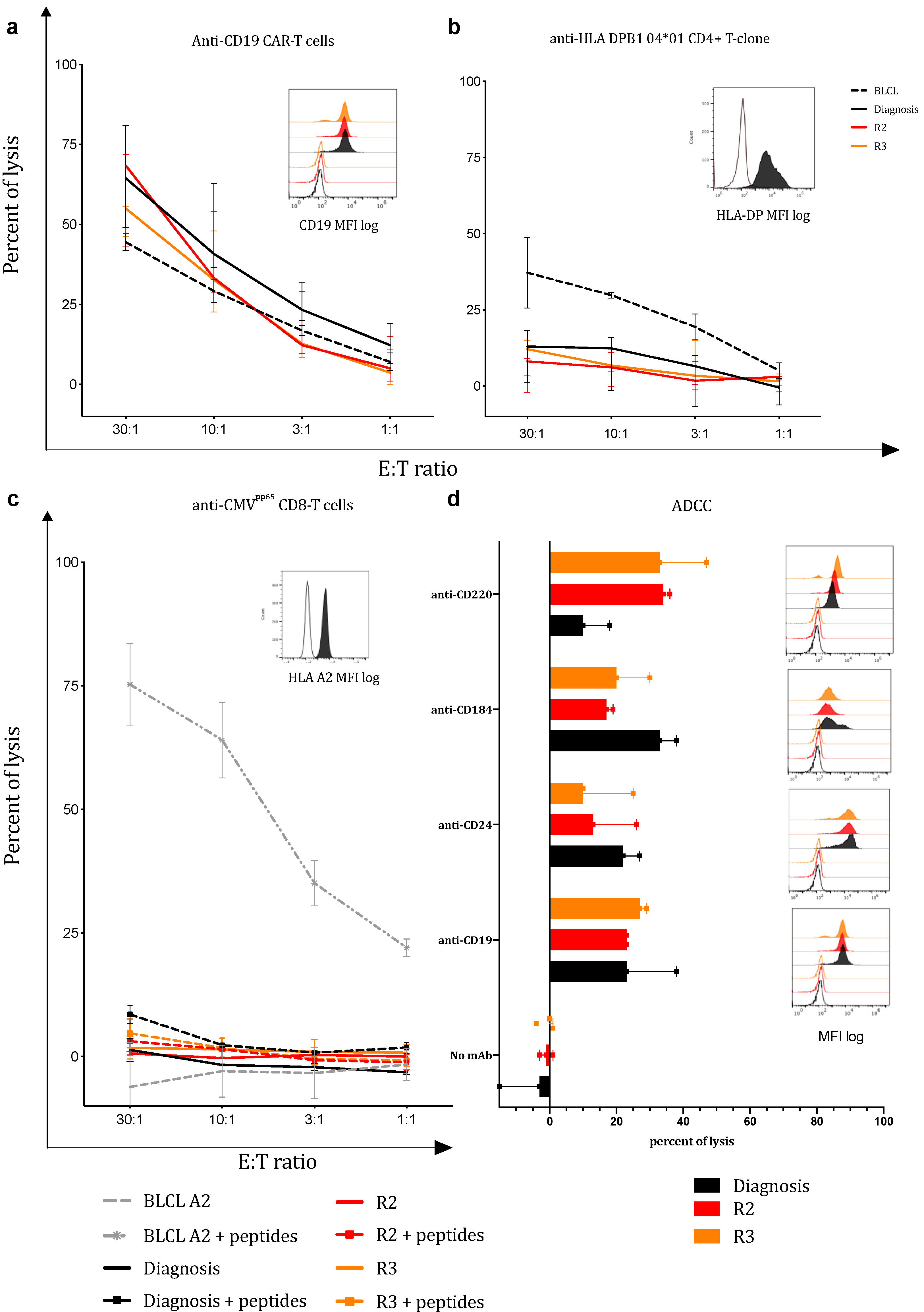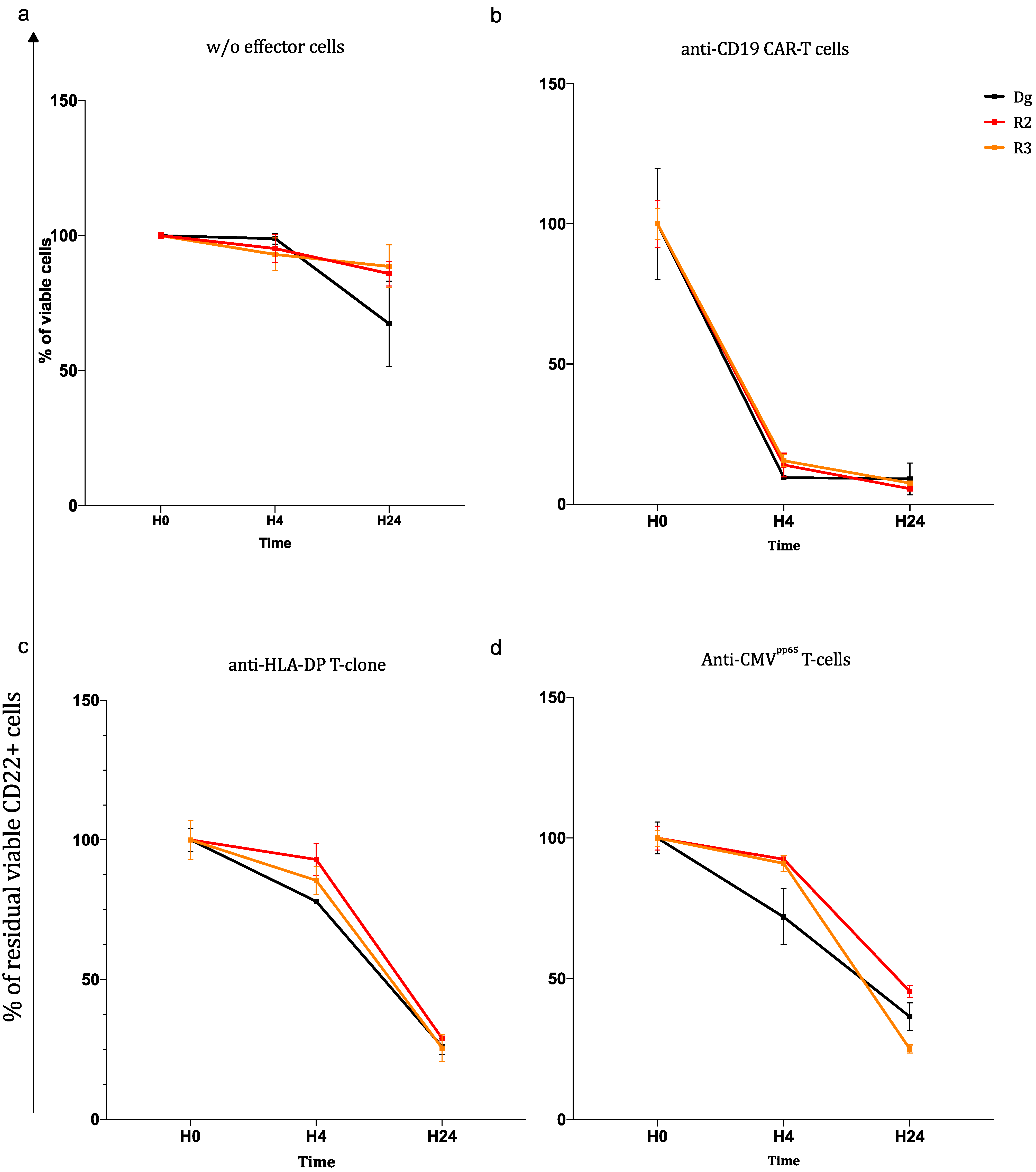Two Ways of Targeting a CD19 Positive Relapse of Acute Lymphoblastic Leukaemia after Anti-CD19 CAR-T Cells
Abstract
1. Introduction
2. Materials and Methods
2.1. Case Description
2.2. Cells
2.2.1. Cell Lines
2.2.2. Effector Cells
- The patient’s anti-CD19 CAR-T cells were collected from residual material in the bag after infusion of tisagenlecleucel. We performed an independent analysis of the cells in our laboratory. Of the CD3+ cells, 11% were CAR+. This result was close to that reported in the manufacturer certificate. The CD4+/CD8+ ratio among CAR+ cells was 3.4 (77.5% CD4+ and 22.3% CD8+). CAR-T cells were largely composed of a differentiated T-cell subset, with CD62L+, CCR7−, and CD45RA− phenotypes.
- Because the tisagenlecleucel preparation only contained 9% of anti-CD19-CAR+ T-cells, the anti-CD19-CAR+ cells were selected with a CD19 biotin-coupled protein (Miltenyi Biotec). An APC-coupled anti-biotin antibody was then used for FACS-sorting the anti-CD19-CAR+ cells. This T-cell population containing 95% of anti-CD19-CAR+ T-cells (of which 71% were CD8+ and 12% were CD4+) was used for the cytotoxic assays. Note that the remaining 7% of CD4- and CD8− cells were composed of 72% of αβ-T lymphocytes and 28% of Υδ-T lymphocytes.
- The anti-HLA-DPB1*04:01 CD4+ T-clone has been previously described [10]. Cells were grown in RPMI 1640 culture medium (Eurobio) supplemented with 8% human serum, 300 IU/mL IL-2, 2 mM l-glutamine, penicillin, and streptomycin (Gibco).
- An anti-CMVpp65 polyclonal CD8+-T-cell population was obtained as previously described [11] and grown in the same culture media.
- A CD8+ polyclonal T cell population transduced by a retroviral vector expressing a chimeric-receptor containing the murine CD16 receptor murine FcɣRIII, linked to the human-chain FcɛRIɣ, was obtained as previously described and used to perform antibody-dependent cell-mediated cytotoxicity (ADCC) assays with murine antibodies [12].
2.3. Immunophenotype
2.4. Cytotoxicity Assays
2.4.1. 51. Cr Assays
2.4.2. Long-Term Killing Assays
3. Results
3.1. ALL Immunophenotypes
3.2. Lysis Sensitivity Mediated by T-Cells Using Different Recognition Pathways: Anti-CD19 -CAR, ADCC, and TCR:
3.2.1. The Anti-CD19 CAR Pathway
3.2.2. The ADCC Pathway
3.2.3. The TCR Pathway
4. Discussion
Supplementary Materials
Author Contributions
Funding
Institutional Review Board Statement
Informed Consent Statement
Data Availability Statement
Acknowledgments
Conflicts of Interest
References
- Maude, S.L.; Laetsch, T.W.; Buechner, J.; Rives, S.; Boyer, M.; Bittencourt, H.; Bader, P.; Verneris, M.R.; Stefanski, H.E.; Myers, G.D.; et al. Tisagenlecleucel in children and young adults with B-cell lymphoblastic leukemia. N. Engl. J. Med. 2018, 378, 439–448. [Google Scholar] [CrossRef] [PubMed]
- Dourthe, M.E.; Rabian, F.; Yakouben, K.; Chevillon, F.; Cabannes-Hamy, A.; Méchinaud, F.; Grain, A.; Chaillou, D.; Rahal, I.; Caillat-Zucman, S.; et al. Determinants of CD19-positive vs CD19-negative relapse after tisagenlecleucel for B-cell acute lymphoblastic leukemia. Leukemia 2021, 35, 3383–3393. [Google Scholar] [CrossRef] [PubMed]
- Grupp, S.A.; Maude, S.L.; Rives, S.; Baruchel, A.; Boyer, M.W.; Bittencourt, H.; Bader, P.; Büchner, J.; Laetsch, T.W.; Stefanski, H.; et al. Updated analysis of the efficacy and safety of tisagenlecleucel in pediatric and young adult patients with relapsed/refractory (r/r) acute lymphoblastic leukemia. Blood 2018, 132, 895. [Google Scholar] [CrossRef]
- Nie, Y.; Lu, W.; Chen, D.; Tu, H.; Guo, Z.; Zhou, X.; Li, M.; Tu, S.; Li, Y. Mechanisms underlying CD19-positive ALL relapse after anti-CD19 CAR T cell therapy and associated strategies. Biomark. Res. 2020, 8, 1–17. [Google Scholar] [CrossRef] [PubMed]
- Guha, P.; Cunetta, M.; Somasundar, P.; Espat, N.J.; Junghans, R.P.; Katz, S.C. Frontline Science: Functionally impaired geriatric CAR-T cells rescued by increased α5β1 integrin expression. J. Leukoc. Biol. 2017, 102, 201–208. [Google Scholar] [CrossRef] [PubMed]
- Holland, E.M.; Molina, J.C.; Dede, K.; Moyer, D.; Zhou, T.; Yuan, C.M.; Wang, H.-W.; Stetler-Stevenson, M.; Mackall, C.; Fry, T.J.; et al. Efficacy of second CAR-T (CART2) infusion limited by poor CART expansion and antigen modulation. J. Immunother. Cancer 2022, 10, e004483. [Google Scholar] [CrossRef] [PubMed]
- Maude, S.L.; Hucks, G.E.; Seif, A.E.; Talekar, M.K.; Teachey, D.T.; Baniewicz, D.; Callahan, C.; Gonzalez, V.; Nazimuddin, F.; Gupta, M.; et al. The effect of pembrolizumab in combination with CD19-targeted chimeric antigen receptor (CAR) T cells in relapsed acute lymphoblastic leukemia (ALL). J. Clin. Oncol. 2017, 35, 103. [Google Scholar] [CrossRef]
- JJaeger, U.; Worel, N.; McGuirk, J.; Riedell, P.A.; Fleury, I.; Borchmann, P.; Du, Y.; Abdelhady, A.M.; Han, X.; Martinez-Prieto, M.; et al. Safety and efficacy of tisagenlecleucel (tisa-cel) plus pembrolizumab (pembro) in patients (pts) with relapsed/refractory diffuse large B-cell lymphoma (r/r DLBCL): Updated analysis of the phase 1b PORTIA study. J. Clin. Oncol. 2021, 39, e19537. [Google Scholar] [CrossRef]
- Cao, Y.; Lu, W.; Sun, R.; Jin, X.; Cheng, L.; He, X.; Wang, L.; Yuan, T.; Lyu, C.; Zhao, M. Anti-CD19 chimeric antigen receptor T cells in combination with nivolumab are safe and effective against relapsed/refractory B-cell non-Hodgkin lymphoma. Front. Oncol. 2019, 9, 767. [Google Scholar] [CrossRef]
- Vivien, R.; Saïagh, S.; Lemarre, P.; Chabaud, V.; Jesson, B.; Godon, C.; Jarry, U.; Guillaume, T.; Chevallier, P.; Vié, H.; et al. The doubling potential of T lymphocytes allows clinical-grade production of a bank of genetically modified monoclonal T-cell populations. Cytotherapy 2018, 20, 436–452. [Google Scholar] [CrossRef]
- Gallot, G.; Vivien, R.; Ibisch, C.; Lulé, J.; Davrinche, C.; Gaschet, J.; Vié, H. Purification of Ag-specific T lymphocytes after direct peripheral blood mononuclear cell stimulation followed by CD25 selection. I. Application to CD4+ or CD8+ cytomegalovirus phosphoprotein pp65 epitope determination. J. Immunol. 2001, 167, 4196–4206. [Google Scholar] [CrossRef] [PubMed]
- Ollier, J.; Vivien, R.; Vié, H.; Clémenceau, B. Transfection of FcγRIIIa (CD16) Alone Can Be Sufficient To Enable Human αβTCR T Lymphocytes To Mediate Antibody-Dependent Cellular Cytotoxicity. ImmunoHorizons 2017, 1, 63–70. [Google Scholar] [CrossRef]
- Liu, D.; Badeti, S.; Dotti, G.; Jiang, J.G.; Wang, H.; Dermody, J.; Soteropoulos, P.; Streck, D.; Birge, R.B.; Liu, C. The role of immunological synapse in predicting the efficacy of chimeric antigen receptor (CAR) immunotherapy. Cell Commun. Signal. 2020, 18, 134. [Google Scholar] [CrossRef]
- Cao, J.; Cheng, H.; Shi, M.; Wang, G.; Chen, W.; Qi, K.; Li, H.; Qiao, J.; Zhao, J.; Wu, Q.; et al. Humanized CD19-specific chimeric antigen-receptor T-cells in 2 adults with newly diagnosed B-cell acute lymphoblastic leukemia. Leukemia 2019, 33, 2751–2753. [Google Scholar] [CrossRef] [PubMed]
- Maude, S.L.; Barrett, D.M.; Rheingold, S.R.; Aplenc, R.; Teachey, D.T.; Callahan, C.; Shaw, P.A.; Brogdon, J.; Young, R.; Scholler, J.; et al. Efficacy of humanized CD19-targeted chimeric antigen receptor (CAR)-modified T cells in children with relapsed ALL. J. Clin. Oncol. 2016, 34, 3007. [Google Scholar] [CrossRef]
- Jiménez-Morales, S.; Aranda-Uribe, I.S.; Pérez-Amado, C.J.; Ramírez-Bello, J.; Hidalgo-Miranda, A. Mechanisms of Immunosuppressive Tumor Evasion: Focus on Acute Lymphoblastic Leukemia. Front. Immunol. 2021, 12, 737340. [Google Scholar] [CrossRef] [PubMed]
- Kang, S.H.; Hwang, H.J.; Yoo, J.W.; Kim, H.; Choi, E.S.; Hwang, S.H.; Cho, Y.U.; Jang, S.; Park, C.J.; Im, H.J.; et al. Expression of immune checkpoint receptors on T-cells and their ligands on leukemia blasts in childhood acute leukemia. Anticancer Res. 2019, 39, 5531–5539. [Google Scholar] [CrossRef]
- Kebelmann-Betzing, C.; Körner, G.; Badiali, L.; Buchwald, D.; Möricke, A.; Korte, A.; Köchling, J.; Wu, S.; Kappelmeier, D.; Oettel, K.; et al. Characterization of cytokine, growth factor receptor, costimulatory and adhesion molecule expression patterns of bone marrow blasts in relapsed childhood B cell precursor all. Cytokine 2001, 13, 39–50. [Google Scholar] [CrossRef]
- Luczyński, W.; Stasiak-Barmuta, A.; Iłendo, E.; Kovalchuk, O.; Krawczuk-Rybak, M.; Malinowska, I.; Mitura-Lesiuk, M.; Chyczewski, L.; Matysiak, M.; Kowalczyk, J.; et al. Low expression of costimulatory molecules and mRNA for cytokines are important mechanisms of immunosuppression in acute lymphoblastic leukemia in children? Neoplasma 2006, 53, 301–304. [Google Scholar]
- Simone, R.; Tenca, C.; Fais, F.; Luciani, M.; De Rossi, G.; Pesce, G.; Bagnasco, M.; Saverino, D. A soluble form of CTLA-4 is present in paediatric patients with acute lymphoblastic leukaemia and correlates with CD1d+ expression. PloS ONE 2012, 7, e44654. [Google Scholar] [CrossRef]
- Titov, A.; Kaminskiy, Y.; Ganeeva, I.; Zmievskaya, E.; Valiullina, A.; Rakhmatullina, A.; Petukhov, A.; Miftakhova, R.; Rizvanov, A.A.; Bulatov, E. Knowns and Unknowns about CAR-T Cell Dysfunction. Cancers 2022, 14, 1078. [Google Scholar] [CrossRef] [PubMed]
- Bourbon, E.; Sesques, P.; Gossez, M.; Tordo, J.; Ferrant, E.; Safar, V.; Wallet, F.; Aussedat, G.; Maarek, A.; Bouafia, F.; et al. HLA-DR expression on monocytes and outcome of anti-CD19 CAR-T cell therapy for large B-cell lymphoma. Blood Adv. 2022. [CrossRef] [PubMed]
- Mengos, A.E.; Gastineau, D.A.; Gustafson, M.P. The CD14+HLA-DRlo/neg Monocyte: An Immunosuppressive Phenotype That Restrains Responses to Cancer Immunotherapy. Front. Immunol. 2019, 10, 1147. [Google Scholar] [CrossRef] [PubMed]
- Stroncek, D.F.; Ren, J.; Lee, D.W.; Tran, M.; Frodigh, S.E.; Sabatino, M.; Khuu, H.; Merchant, M.S.; Mackall, C.L. Myeloid cells in peripheral blood mononuclear cell concentrates inhibit the expansion of chimeric antigen receptor T cells. Cytotherapy 2016, 18, 893–901. [Google Scholar] [CrossRef] [PubMed]



Disclaimer/Publisher’s Note: The statements, opinions and data contained in all publications are solely those of the individual author(s) and contributor(s) and not of MDPI and/or the editor(s). MDPI and/or the editor(s) disclaim responsibility for any injury to people or property resulting from any ideas, methods, instructions or products referred to in the content. |
© 2023 by the authors. Licensee MDPI, Basel, Switzerland. This article is an open access article distributed under the terms and conditions of the Creative Commons Attribution (CC BY) license (https://creativecommons.org/licenses/by/4.0/).
Share and Cite
Grain, A.; Ollier, J.; Guillaume, T.; Chevallier, P.; Le Calvez, B.; Eveillard, M.; Clémenceau, B. Two Ways of Targeting a CD19 Positive Relapse of Acute Lymphoblastic Leukaemia after Anti-CD19 CAR-T Cells. Biomedicines 2023, 11, 345. https://doi.org/10.3390/biomedicines11020345
Grain A, Ollier J, Guillaume T, Chevallier P, Le Calvez B, Eveillard M, Clémenceau B. Two Ways of Targeting a CD19 Positive Relapse of Acute Lymphoblastic Leukaemia after Anti-CD19 CAR-T Cells. Biomedicines. 2023; 11(2):345. https://doi.org/10.3390/biomedicines11020345
Chicago/Turabian StyleGrain, Audrey, Jocelyn Ollier, Thierry Guillaume, Patrice Chevallier, Baptiste Le Calvez, Marion Eveillard, and Béatrice Clémenceau. 2023. "Two Ways of Targeting a CD19 Positive Relapse of Acute Lymphoblastic Leukaemia after Anti-CD19 CAR-T Cells" Biomedicines 11, no. 2: 345. https://doi.org/10.3390/biomedicines11020345
APA StyleGrain, A., Ollier, J., Guillaume, T., Chevallier, P., Le Calvez, B., Eveillard, M., & Clémenceau, B. (2023). Two Ways of Targeting a CD19 Positive Relapse of Acute Lymphoblastic Leukaemia after Anti-CD19 CAR-T Cells. Biomedicines, 11(2), 345. https://doi.org/10.3390/biomedicines11020345




